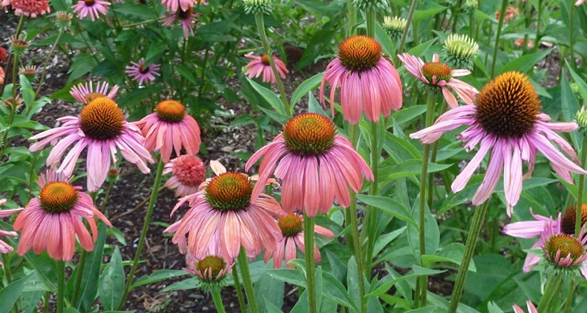For commercial property owners and managers looking for non-traditional landscape approaches to take their office, mall, business park, school, or health care facility up a notch, look no further than transitioning high maintenance and underutilized turf and lawn areas to a perennial meadow.
Perennials are versatile plants that offer an infinite number of creative combinations when it comes to color, form, and texture. “The more species you include in your plant mix, the healthier it is,” said Bruce Moore, Jr., ELMs Vice President of Operations and a second-generation horticulturist. “While turf and lawn areas are typically made up of a single type grass, a cohesive palette of natural vegetation, ornamental grasses and flowering groundcovers improves the health of the soil and can act as a living mulch.”
In addition to emerging as a growing landscape and green design trend, meadow approaches are providing important ecological benefits well beyond aesthetics, attracting pollinators, songbirds, and beneficial insects. With less maintenance required overall, meadow plantings can offer cost savings over traditional sod.
According to Moore, the first three years of a meadow planting require time to fully develop. Once established, however, the plants become cost efficient (from reduced maintenance, reduced water, fertilizer and extra care turf might require), and the return on investment can be realized in less than half that time.
ELMs advocacy for re-imagined lawn alternatives has taken on new relevancy as ongoing drought concerns impact greater Fairfield County, Connecticut and parts of New York, an area ELM has served for more than 40 years.
Careful planning will ensure that the perennials and grasses integrate and compete well with other landscaped areas. “One of the best applications for this naturalistic aesthetic is in its power to transform parking lots,” said Moore.
“Parking lot renovations that incorporate sustainable characteristics and easy-care perennials overtime offer significant environmental and cost improvements. In winter, we’re finding that parking lots planted with both hardy natives and other appropriate plants suffer less damage when equipment is clearing away snow and ice.”
For more information on green infrastructure and sustainable landscape maintenance for commercial properties (bioswales, bioretention areas, turf, meadows, landscape and tree plant palettes), contact Bruce Moore @ 203-316-5433.
© Photo credit: Masshort.org

